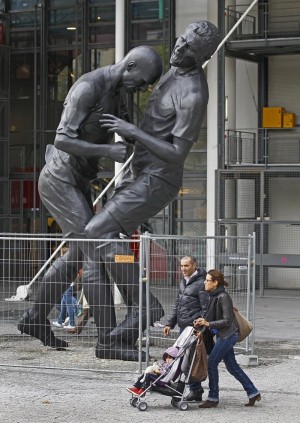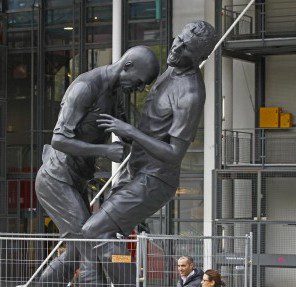What if one of your worst moments as a human being was sculpted into a 16-foot-tall bronze statue and displayed in front of a shopping mall? Or a Parisian art museum?
Zinedine Zidane knows how that brand of shameful memorializing feels. Zidane, the former soccer star who led France to its only World Cup championship in 1998, became a French cultural icon in the ’90s. He led France’s national team from his position in central midfield, controlling the ball deftly, switching directions with superhuman quickness, displaying near-divine precision when he passed the ball. Thanks to all this, Zidane—whose parents were from northern Algeria—was the best-known player on a racially and ethnically diverse team that made many French citizens feel as though their nation had transcended its colonialist history. The son of immigrants became a hero to soccer fans all over the world, but in France Zidane’s biography made him more than a sports figure with a cool name.
In 2006, eight years after leading France to world football dominance for the first time, an aging Zidane powered the French team to yet another World Cup final. What he’d lost in youthful quickness, Zidane made up for with his ageless sixth sense for placing beautiful, curving passes at the feet of sprinting teammates. Zidane had come to occupy that hackneyed but irresistible sports archetype, the savvy veteran, with an extra dash of style and power. But throughout the final match of that 2006 World Cup, the Italian defender Marco Materazzi baited Zidane by saying nasty things about the French star’s sister. In the second half, an increasingly agitated Zidane—maybe forgetting that millions and millions of people were watching the match—lashed out with a ferocious head-butt, hammering his skull straight into the defender’s sternum, sending Materazzi sprawling backwards, shouting in pain.
 This is the very moment that the French artist Adel Abdessemed captured in a giant bronze sculpture that now stands outside the Pompidou Center in Paris. The enormous sculpture captures the contours and wrinkles of the two players’ jerseys, the grounded, goat-like stance of the butting Zidane, the graceless backward flop of Materazzi. The imposing twinned statues are all dark metal, a bit H. R. Geiger-ish in their sleek violence (and also, as Scott Sayare nicely observed in the Times’ Artsbeat blog, the sculpture echoes some giant, bleak Soviet-era sculpture). Abdessemed, the sculptor, who claims Algerian heritage similar to Zidane’s, told Sayare that the soccer icon’s attack “offered us a rapture” because Zidane, in that moment of aggression, “expressed himself as a man.”
This is the very moment that the French artist Adel Abdessemed captured in a giant bronze sculpture that now stands outside the Pompidou Center in Paris. The enormous sculpture captures the contours and wrinkles of the two players’ jerseys, the grounded, goat-like stance of the butting Zidane, the graceless backward flop of Materazzi. The imposing twinned statues are all dark metal, a bit H. R. Geiger-ish in their sleek violence (and also, as Scott Sayare nicely observed in the Times’ Artsbeat blog, the sculpture echoes some giant, bleak Soviet-era sculpture). Abdessemed, the sculptor, who claims Algerian heritage similar to Zidane’s, told Sayare that the soccer icon’s attack “offered us a rapture” because Zidane, in that moment of aggression, “expressed himself as a man.”
I remember just where I watched that World Cup final in 2006. I was standing in the backyard of a Brooklyn bar called Cherry Tree, holding a pint of beer. The game was being projected onto a mostly taut white sheet, and the moving images of the action were pale and sometimes hard to see in the summer sunlight. I was following the match in a distracted way, talking to friends, drinking, thinking how nice it was that people could bring their dogs. I’m pretty sure someone was trying to roast a pig in a shallow trench back there, which would have drawn some portion of my attention, too. But at one point I looked up at the screen and saw it—saw something: was that Zidane? Was that Zidane head-butting somebody? The ghosts on the screen were difficult to make out, but yes, the replays made it clear: Zinedine Zidane, one of the world’s most admired athletes and one of my personal soccer heroes, had violently head-butted an opponent and then been red-carded—thrown out—of the World Cup final. I was stunned.
Now, six years later, a gigantic sculpture of Zidane’s disgrace looms outside a Paris museum and library complex. What to make of this? I admire Abdessemed’s sculpture, or at least I admire its conceptual roots, because I think the artwork shows something about the mythical status we accord our most talented athletes. Maybe portraits of shamed or injured sports stars are as close as we can come to resonant religious images in our century. But the sculptor’s contention that this moment amounts to a “rapture” seems wrongheaded to me. Both men played their part: Materazzi’s weird, elaborate pseudo-Iago act remains villainous as ever, and Zidane’s response still seems immature and shameful. But beyond the sculpture, the rapture is still there—in the memories of Zidane’s play, the moves he produced impromptu, eluding and eliding, gliding around the field like a ghost who became more substantial (and somehow quicker) when his feet touched the ball. There is no easy redemption in Zidane’s story, nothing like Barry Zito regaining championship form for the San Francisco Giants after blowing it for so many years. But Zidane’s awful lapse of judgment is not an egregious Lance Armstrong-esque fall from grace, either. The rapture of the French midfielder’s play is still there in the collective memory of those who watched him; you can see it, too, in the documentary Zidane: A 21st Century Portrait. This strange and strangely compelling film used 17 different cameras to record Zidane’s movement and stillness during the course of a single 90-minute game. The movie is slow at times, but Zidane’s transitions from expectant jogging to sudden bursts of skill are where the real rapture lies. And no one can bronze those subtle flickers of intelligent play, which is at least partly why they’re beautiful.





3 responses
Thanks for this, for the reminder of the pleasures of watching Zidane & for this strange news story. I became a fan of Zidane’s without knowing anything about soccer, purely through watching “Zidane: A 21st Century Portrait.” The movie has its longeurs, but even the slow parts have the structure of cinematic fascination itself: one is focused intently on Zidane’s focused attention, for 90 minutes. The few voiceovers are stunning, letting us in at last.
I’ve watched some fan compilations on youtube since then; they showcase his “intelligent play,” but only in a static, highlight-reel way–they’re the bronze-statue version of Zidane in motion.
I, too, would shy from the word “rapture” to describe this immortal sports moment (the statue is redundant to the immortality), and I don’t think there was anything particularly masculine about Zidane’s lapse of self-control (so shocking against the backdrop of his elegance as a player and person), but like the author and so many others I remember it vividly, and I can’t deny that its visceral power owed something to the ecstasy of release. The Italians had played filthy through the entire tournament, and Materazzi epitomized the cynicism of their tactics. Materazzi *counted* on Zidane’s strength of character and his devotion to the beautiful game; he used them to get under the Frenchman’s skin. While he succeeded in turning Zidane’s virtues against him, we had at least the guilty satisfaction of seeing this Iago knocked on his butt. (My own monument to this tragic but exhilarating episode took a more ephemeral form: I taught my cat to head butt my chest when given the cue “Zidane.”)
Compare Zidane’s eruption to Nigel de Jong’s planting of his cleats in Xabi Alonso’s ribs in the last World Cup final to get a sense of how character may tell even in an act of violence.
Call Materazzi a villain, the italians cheaters or what have you, but my own image of Zidane, head hanging low, name shamed in red, his back to the shimmering world cup trophy, slumping away, and Materazzi smiling in the sunshine next to the strong arms of his capitano Cannavaro raising said trophy with his team, will be burned in my mind forever. A team that conceded no opponents goals during open play, viva el Catenaccio! As Claudio Gentile said, “El futbol no es para bailarinas.”
Click here to subscribe today and leave your comment.